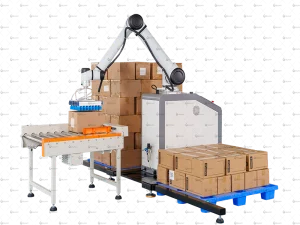Workplace efficiency is the holy grail of modern manufacturing, packaging, and logistics. Every company is searching for ways to increase speed, reduce costs, and improve accuracy—all without overburdening their workforce. Enter palletizing robots: highly advanced machines designed to stack, arrange, and handle products on pallets with precision. But the real question is: Can palletizing robots improve work efficiency?
The short answer is a resounding yes—but the why and how are what matter. In this guide, we’ll explore the benefits, answer frequently asked questions, share real insights, and explain why robotic palletizers are transforming industries worldwide.
The Rise of Robotic Palletizing
Robotic automation has been steadily reshaping industries for decades, but palletizing stands out as one of the clearest areas where the payoff is immediate. Traditionally, manual palletizing has been physically exhausting, error-prone, and slow. Workers often face fatigue, injuries, and inconsistent results. Palletizing robots solve these issues by:
- Working around the clock with zero downtime.
- Maintaining consistent accuracy in stacking.
- Reducing labor costs tied to repetitive, heavy lifting.
A study from the International Federation of Robotics (IFR) found that robotic automation can increase productivity by 20–40% in logistics and packaging operations.
palletizing robots
Benefits of Palletizing Robots for Efficiency
1. Faster Throughput
Robots can handle up to 1,500 cycles per hour, depending on product size and weight. This is far beyond what even the most skilled human worker can achieve consistently.
2. Accuracy and Consistency
A misplaced box may seem small, but multiplied across thousands of pallets, errors waste space, cause instability, and increase costs. Robots stack with precision, ensuring every pallet is uniform and secure.
3. Labor Optimization
Manual palletizing is one of the top causes of workplace back injuries. Robots free human workers from repetitive strain, allowing them to focus on higher-value tasks like quality checks and line supervision.
4. Flexibility Across SKUs
Modern palletizers can switch between product types with minimal downtime. Whether it’s cartons, bags, or bottles, robotic palletizers handle variety with ease.
5. Cost Savings in the Long Run
Although the upfront investment can feel significant, many companies report a return on investment (ROI) within 2–3 years, thanks to reduced labor costs, fewer errors, and higher productivity.
Frequently Asked Questions
Q1: Are palletizing robots only for large companies?
Not at all. While large-scale operations adopted them first, today’s palletizing robots are more affordable and scalable. Small to medium businesses can also benefit from entry-level models.
Q2: Do palletizing robots replace human jobs?
They reduce the need for manual lifting but don’t eliminate human roles. Instead, workers transition to safer, more skilled positions such as robot programming, supervision, and maintenance.
Q3: What industries benefit the most?
Food and beverage, pharmaceuticals, e-commerce, construction materials, textiles, and chemicals all rely on palletizing robots to boost efficiency.
Q4: How do palletizing robots affect product safety?
By minimizing handling errors and stacking consistently, robots reduce product damage during transport. This directly improves supply chain reliability.
Why Palletizing Robots Are the Future
Consider a scenario: A warehouse team struggles to meet shipping deadlines during peak season. Manual workers tire after a few hours, and pallet stacks vary in quality. By introducing robotic palletizers, the same warehouse not only meets demand but exceeds it—delivering products faster, safer, and with fewer errors.
This isn’t just futuristic thinking—it’s happening today. Companies across the globe report 20–50% improvements in efficiency after adopting robotic palletizing systems.
So, can palletizing robots improve work efficiency? The evidence is clear: Yes, they can—and they do. By combining speed, accuracy, safety, and cost savings, palletizing robots are revolutionizing the way industries handle logistics. For businesses aiming to stay competitive in an increasingly demanding marketplace, investing in robotic palletizers is no longer optional—it’s essential.

